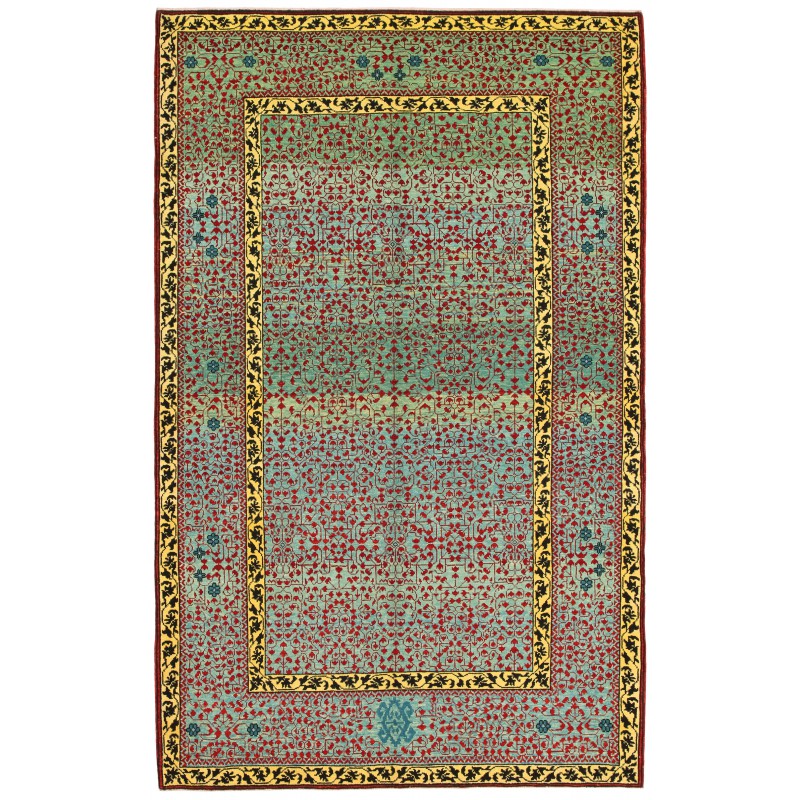
- Stock: 売り切れ
- Model: C40129
- サイズ: 133cm x 212cm
この絨毯の情報源は、書籍『Die orientalischen Knüpfteppiche das MAK』、アンジェラ・フェルカー、ウィーン: ベルハウ、2001年: 42–5 です。この中央の星がデザインされた絨毯は、エジプトのカイロにあるマムルーク朝のスルタンによって16世紀初頭に作られました。ウィーンの応用美術博物館(MAK)で展示されています。その印象的なサイズ、素材、デザインの品質から判断すると、この絨毯は熟練した宮廷工房の製品であり、おそらく最後のマムルーク朝の後期に作られたものです。使用されている色の多さから、制作時期は1500年頃と推測されます。葉のつると特徴的な傘の葉を持つ繊細な植物模様のボーダーは、後の時期を示しています。1517年、オスマン帝国がマムルーク朝を征服しましたが、カイロの絨毯工房はマムルーク様式の作品を16世紀中盤まで製作し続けました。
カイロの工房で製作された初期の絨毯を読み解くことは、まったく異なる課題を提起します。カイロの絨毯は、限られた色のパレット、対称的な結び目、そしてイスラム世界のほとんどで通常使用されるZ-結びのウールとは異なる特殊なS-結びウールの構造によって特徴付けられます。しかし、オスマン帝国が1517年にマムルーク朝を征服した後、デザインは急激に変化しました。シモネッティ絨毯はおそらく征服後に織られたものであり、マムルーク朝の15世紀のスタイルを持っています。縦長で狭い形状で、エジプトの標準サイズのローラービーム織機で織られ、さまざまな長さの絨毯を生産することができました。デザインはA-B-C-B-Aのパターンで、5つの主要なデザインエリアがあります。これらのデザインエリアはメダリオンと呼べますが、レイアウトとディテールの両方が幾何学的であり、そのスタイルはメダリオン形式が生まれる以前のものです。マムルーク絨毯のデザインと色彩は、赤、青、緑、そして時に黄色などの昆虫由来の色を異常に組み合わせ、ほとんど無染色の白を使用しないことから、早期近代市場で認識可能なブランドを作り出す試みであると言えます。特にヨーロッパでは、このようなマムルーク絨毯は繊細な色彩、非常に詳細なデザイン、小さな複雑な幾何学的なモチーフのモザイクのようなレイアウトを持ち、アナトリアのより粗く織られ、鮮やかな色彩の絨毯、例えばウシャクのメダリオン絨毯とは異なる魅力的な選択肢でした。伝統的な幾何学的なマムルークデザインの絨毯の織りは17世紀まで続いたようですが、16世紀中頃を境に、カイロの織工はマムルークの伝統的な材料、技法、色使いを活かしつつ、イスタンブールのオスマンスルタンの宮廷で生み出されている最新のスタイルを反映した、まったく新しい種類の絨毯を作り始めました。この絨毯のデザインは、カスタムロゴとともに私たちのデザイナーによって解釈され、ソフトな色が使用されています。
The source of the rug comes from the book Völker, Angela, Die orientalischen Knüpfteppiche das MAK, Vienna: Böhlau, 2001: 42–5. This rug with the central star was designed in the early 16th-century rug by Mamluk Sultane of Cairo, Egypt. It is exhibited at MAK – Museum of Applied Arts, Vienna Austria. As its impressive size, materials, and design quality suggest, the carpet is a product of an accomplished court workshop and likely dates from the late period of the last Mamluk dynasty. The quantity of the colors used speaks for an earlier date around 1500; the delicate vegetal border with leaf tendrils and the characteristic umbrella leaves rather point to a later date. In 1517, the Ottomans conquered the Mamluk Empire, but Cairo’s carpet workshops still produced pieces until the mid-16th century in a post-Mamluk style.
Attempting to read early carpets produced in workshops in Cairo provides an entirely different set of challenges. Cairene carpets, distinguished by their limited color palette, symmetrical knotting, and unusual construction of S-spun wool (Z-spun wool being the norm almost everywhere in the Islamic world), underwent a sudden change in design sometime after the Ottoman Turks conquered the Mamluk Empire in 1517. The Simonetti Carpet was probably woven after the conquest but exhibits the “old” fifteenth-century style of the Mamluks. Long and narrow, it was woven on a standard-sized Egyptian roller-beam loom, capable of producing carpets of varying lengths. It consists of five major focal areas of design in an A-B-C-B-A pattern, meaning the first and fifth and the second and fourth areas are paired, while the middle is unique. We can easily term these five focal areas medallions, but they are geometric in both layout and detail, and their style (as opposed to the actual date of the weaving) predates the carpet design revolution that gave rise to the medallion format. We can surmise that the designs and colors of Mamluk carpets, with their unusual combination of insect-derived red, blue, green, and sometimes yellow, with virtually no undyed white at all, constitute an effort to create a recognizable brand in the early modern market, especially in Europe, where Mamluk carpets such as this, with their subtle coloration, incredibly detailed design, and mosaic-like layout of small and intricately patterned geometric motifs, constituted an appealing alternative to the more coarsely woven and brightly colored carpets from Anatolia, such as Ushak medallion carpets. While the weaving of carpets in the traditional geometric Mamluk designs apparently continued well into the seventeenth century, sometime around the mid-sixteenth century, Cairene weavers began to create an entirely new kind of carpet, using their traditional Mamluk materials, technique, and coloration but reflecting the latest styles then being created at the court of the Ottoman sultans in Istanbul. The design of the rug is interpreted by our designers with a customized logo, soft colors are used for this rug.
